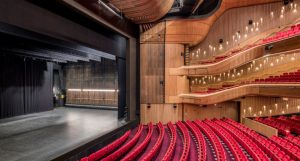Unveiling the Most Common Types of Curtains in Theatres and Performing Arts Centre’s.
Introduction
Behind the scenes of a theatre or Performing Arts Centre lies an array of elements working together to create the perfect stage setting, including the ubiquitous curtains. These curtains add visual appeal, provide masking to the wings and stage for set changes and improve the acoustic performance of the venue. In this blog post, we’ll explore the most common types of curtains seen and used in theatres and Performing Arts Centre’s, unveiling the artistry and functionality they bring to the stage.
Main Curtain (Grand Drape)
The main curtain, also known as the grand drape or house curtain, is perhaps the most recognizable curtain in a theatre. Positioned at the front of the stage, it serves as a visual barrier between the audience and the performance area. The grand drape is typically made of luxurious velvet or theatre wool, often in rich colors like burgundy, navy, or black. It is commonly either bi-parting (french action) or for a classic look, rigged to a motorized system allowing seamless raising and lowering before, during and after the performance.

Backdrops
Backdrops are large, natural or painted curtains that create the illusion of a specific setting or environment. These curtains are used to establish different scenes or locations throughout a performance either via painting or via projection. Backdrops can be hand-painted, digitally printed or projected onto. These curtains are commonly canvas or muslin fabric. Backdrops can be swapped quickly during scene changes, helping to transport the audience to different worlds within the span of a single performance.

Borders and Legs (Teasers and Tormentors)
Borders, also known as teasers, are horizontal curtains that span the width of the stage, typically positioned at the top to mask the fly loft and lighting fixtures. Legs, also called tormentors, are vertical curtains placed on either side of the stage to hide the wings and backstage areas. Borders and legs help create a defined performance space and provide a clean neutral backdrop for lighting effects. They are often made from heavy black theatre wool fabric and can be adjusted to change the width and height of the stage opening.

Travelers
Travelers, also called stage curtains, tabs or draw curtains, are versatile curtains that can move horizontally across the stage. They are often made from heavy black wool fabric and are used for scene changes, entrances, and exits. Travelers are suspended on tracks and can be opened or closed using a pulley system. These curtains allow for seamless transitions between scenes, adding fluidity to the performance and maintaining the element of surprise.

Cycloramas
Cycloramas, commonly known as cycs, are large curtains that stretch across the back of the stage. Usually made of seamless filled cloth fabric, cycloramas serve as a neutral canvas for lighting effects, projections, or scenic elements. They can be lit from the front or behind to create different moods, colors, and textures. Cycloramas offer a blank slate for creative expression, transforming the stage into limitless possibilities.

Valance
The valance curtain is a decorative curtain that hangs horizontally above and in front of the main curtain. It adds an elegant touch to the stage design and helps to conceal the rigging and hardware at the top of the proscenium. Valance curtains are often made from decorative fabric and can feature intricate patterns or embroidery, complementing the overall aesthetic of the production. Generally, the valance is made from the same fabric as the grand drape / main curtain.

Scrim
A scrim is a versatile and unique type of curtain that is made of a semitransparent material, usually gauze or netting. When lit from the front, it appears opaque, but when lit from behind, it becomes transparent, revealing objects or scenes placed behind it. Scrims are commonly used for magical effects, dream sequences, or creating ghostly appearances.
Conclusion
Curtains are an essential component of any theatre or performing arts centre, enhancing the visual impact of a performance while providing functional elements for scene changes, lighting effects, and creative illusions. From the majestic grand drape to the versatile travelers, the transformative cycloramas, the decorative valance curtain, and the magical scrim, each curtain type serves a unique purpose in creating immersive theatrical experiences. They not only contribute to the aesthetics of the stage but also play a crucial role in setting the mood, establishing different scenes, providing acoustics and captivating the audience.
The artistry and craftsmanship behind these curtains should not be overlooked. Skilled designers, technicians, and artists meticulously create and maintain these curtains, ensuring they are not only visually stunning but also safe and functional. The ability to seamlessly transition between scenes, conceal backstage areas, create illusions, and evoke emotions would not be possible without these carefully designed curtains.
So, the next time you find yourself in a theatre or performing arts centre, take a moment to appreciate the curtains that adorn the stage. These seemingly ordinary elements contribute to the magic and wonder that unfolds before your eyes. They are an integral part of the theatrical experience, elevating performances and allowing audiences to be transported to extraordinary worlds. Curtain up, and let the show begin!
For more information on the drapes ITE offer, please follow this link: ITE Drapes
It is also worth understanding drapery fire retardancy and how it relates to curtains in a theatre. For more information, please see the following link: https://www.whaleys-stages.co.uk/need-know-fire-retardant-fabrics/
